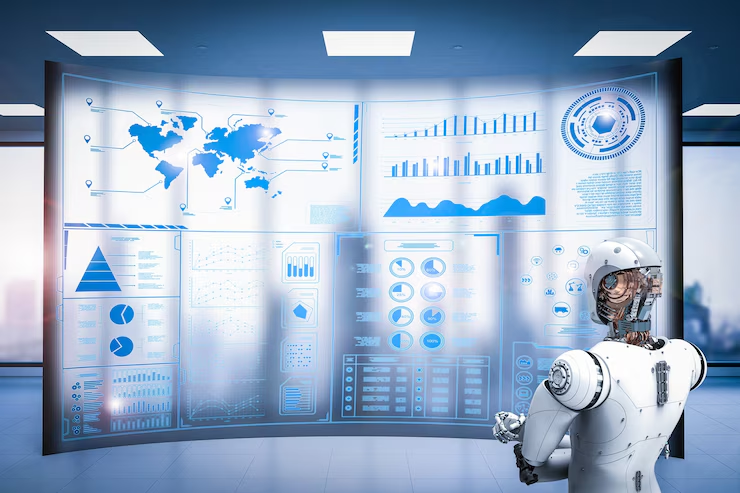Applying ai agents in data analysis helps to reduce time for performing such work and the number of mistakes at the same time. In this guide, you will find what these agents are, how it operates, the type to use, the practical examples, where it can be applied in various industries, the cost you should expect, the benefits of implementing them and what factors to consider if it is not working out as expected. Let’s begin.
What Is AI Agents in Data Analysis? How Do They Work?
An AI agent in the context of Data Analysis is an algorithm which is capable of assessing, filtering and learning from data by itself. It can run tasks with very little assistance from a human being. And so, based on these rules and models a scan is made to categorise and define patterns, then it gives answers or displays visuals.
These agents process input data in their initial form which could be text, numerate or even logs. First of all, they ensure that the data is tempered with by eliminating wrong or blank segments. They are then able to categorize the information either by date, type or groups. It is after this that certain models or simple rules are used to compute trends. In some, they employ machine learning, and this implies they get to learn from the data they have, in order to make predictions on other data. In the last, they create a report or graph for the person to conduct for the decision making.
The main steps are:
1. Input: receives files or information from the database.
2. Correct: It sets the date format, eliminates rows of few ADs, appends missing days and removes wrong entries.
3. Specialised Software: This is used to run a given math, stats or models.
4. Output: Text can be produced in form of charts, tables or synopsis.
Typically the agent is guided with a prompt and / or config file that defines the tasks that it should perform. If you apply artificial intelligence and its agents for data analytics, you free up time on lower value-added activities and stay on value-addition.
What Are The Types Of AI Agents In Data Analytics?
For the purpose of data analysis, there are several main types of AI agents available to you. Each fits a need:
- Rule-Based Agents
These agents follow fixed rules you set. They work well when tasks are clear—for example, flagging rows where sales drop by over 20%. They do not learn but are fast and easy to build with simple ai data analysis software. - Machine Learning Agents
They use algorithms that learn from past data. You feed them labeled data and they learn patterns to make predictions. A model might forecast sales for the next quarter. This type uses more compute power but can spot trends you might miss. - Natural Language Agents
These agents can read text fields and write summaries. They can read customer feedback and spot common themes. They help when data is text or mixed form. You often need an ai development company to tune them well. - Hybrid Agents
They mix rule-based and learning steps. First, rules clean the data, and then a learning model finds hidden trends. They offer a blend of speed and depth and are common in artificial intelligence software development projects. - AutoML Agents
These perform automatic model selection. You give them data and a goal; they pick the best model and tune it. They need less expert input but offer less control over model choices.
When you plan to use ai agents for data analysis, pick the agent type that fits your data and skill level.
Use Cases Of AI Agents In Data Analysis
You can use ai agents for data analysis in many ways. Here are some real cases:
Sales Forecasting
A retail chain uses a machine learning agent to read past sales and promotions and predict demand for each store. They use ai for data analysis to set stock levels, avoiding both overstock and out-of-stock.
Customer Feedback Analysis
A service team uses a natural language agent to read survey text and group feedback into topics like price, quality, and service. They fix common issues faster.
Fraud Detection
A bank uses a hybrid agent: rules flag big transfers at odd hours, and a learning model spots patterns from past fraud. The bank alerts users in real time.
Manufacturing Quality Control
A factory uses an AutoML agent. Cameras scan parts for cracks, and the agent learns to spot defects. It then sends alerts if a bad part appears.
Marketing Campaign Analysis
A marketing agency uses a rule-based agent to track clicks, views, and costs for each ad, and flags campaigns with high cost per sale. The team cuts low-performing ads fast.
These cases show how AI data analysis agents can work in the real world, saving time or cost and uncovering new insights.
Conclusion
AI agents for data analysis offer fast, reliable, and deep insight. You can pick rule-based or learning types and use them in healthcare, finance, retail, and more. You can work with an ai development company or use open-source tools. Costs vary by agent type, data size, and ongoing maintenance. You gain time, cut errors, and scale operations easily. Just keep an eye on data quality, bias, and compute costs. With the right plan, these agents can become a core part of your data science and artificial intelligence work. Start small, learn as you go, and you will see real value from your AI data analysis agents.

